Back Conditions Explained
Sexually Transmitted Diseases (STDs)

We have selected the following expert medical opinion based on its clarity, reliability and accuracy. Credits: Sourced from the National Institute of Health (NIH). Please refer to your own medical practitioner for a final perspective, assessment or evaluation.
Overview
STDs/STIs are a group of illnesses that are passed from person to person during sexual intercourse, oral sex, or certain types of sex play. These diseases can be caused by bacteria, viruses, or parasites and are spread through intimate sexual contact involving the penis, vagina, mouth, or anus or contact with any of the membranes that line the urinary and/or genital tracts. STDs/STIs are also called venereal diseases.
Health care providers often use the term "infection" rather than "disease" because it is possible for a person to have no symptoms but still have the infection and require treatment. Scientists have identified more than 20 different STIs.
Symptoms
What are the symptoms of sexually transmitted diseases (STDs)?
People with STDs/STIs may feel ill and notice some of the following signs and symptoms:
- Unusual discharge from the penis or vagina
- Sores or warts on the genital area
- Painful or frequent urination
- Itching and redness in the genital area
- Blisters or sores in or around the mouth
- Abnormal vaginal odour
- Anal itching, soreness, or bleeding
- Abdominal pain
- Fever
In some cases, people with STIs have no symptoms. Over time, any symptoms that are present may improve on their own. It is also possible for a person to have an STI with no symptoms and then pass it on to others without knowing it.
If you are concerned that you or your sexual partner may have an STI, talk to your health care provider. Even if you do not have symptoms, it is possible you may have an STI that needs treatment to ensure your and your partners’ sexual health.
Causes
What causes sexually transmitted diseases (STDs)?
There are three major causes of STDs/STIs:
- Bacteria, including chlamydia, gonorrhoea, and syphilis
- Viruses, including HIV/AIDS, herpes simplex virus, human papillomavirus, hepatitis B virus, cytomegalovirus (CMV), and Zika
- Parasites, such as trichomonas vaginalis, or insects such as crab lice or scabies mites
Any STI can be spread through sexual activity including sexual intercourse, and some STIs also are spread through oral sex and other sexual activity. Ejaculation does not have to occur for an STI to pass from person to person.
In addition, sharing contaminated needles, such as those used to inject drugs, or using contaminated body piercing or tattooing equipment also can transmit some infections, such as HIV, hepatitis B, and hepatitis C. A few infections can be sexually transmitted but are also spread through nonsexual, close contact. Some of these infections, like CMV, are not considered STIs even though they can be transmitted through sexual contact.
Regardless of how a person is exposed, once a person is infected by an STI, he or she can spread the infection to other people through oral, vaginal, or anal sex, even if he or she has no symptoms.
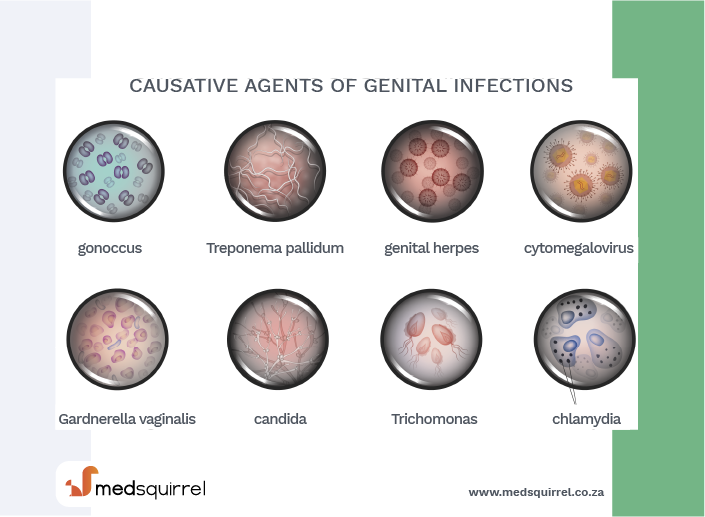
Common STI's
What are the more common sexually transmitted infections (STIs)?
Here are descriptions of some common STIs.
Chlamydia
- Caused by the bacterium Chlamydia trachomatis
- Can be transmitted during vaginal, oral, or anal sexual contact with an infected partner
- Many infected individuals will not experience symptoms, but chlamydia can cause fever, abdominal pain, and unusual discharge from the penis or vagina.
- Can be treated with antibiotics
- If untreated, can cause pelvic inflammatory disease, which can lead to chronic pelvic pain and permanent damage to a woman's reproductive organs. This damage may lead to ectopic pregnancy (in which the foetus develops outside of the womb, a condition that can be life-threatening) and infertility.
- Can be transmitted to foetus during pregnancy or to infant during delivery, causing eye infections or pneumonia. Antibiotic ointment is usually applied to a baby's eyes after birth to treat undetected chlamydia.
- Because chlamydia and gonorrhoea often occur together, people who have one infection are typically treated for both by their health care provider.
- To prevent health complications and sexual transmission, treatment should be provided promptly for all persons testing positive for infection, and recent sexual partners should be treated at the same time to prevent reinfection.
- Infected individuals should follow their health care provider's recommendations about how long to abstain from sex after the treatment is completed to avoid passing the infection back and forth.
Chlamydia micro-organism
Image credit: obtained from the website www.std-gov.org
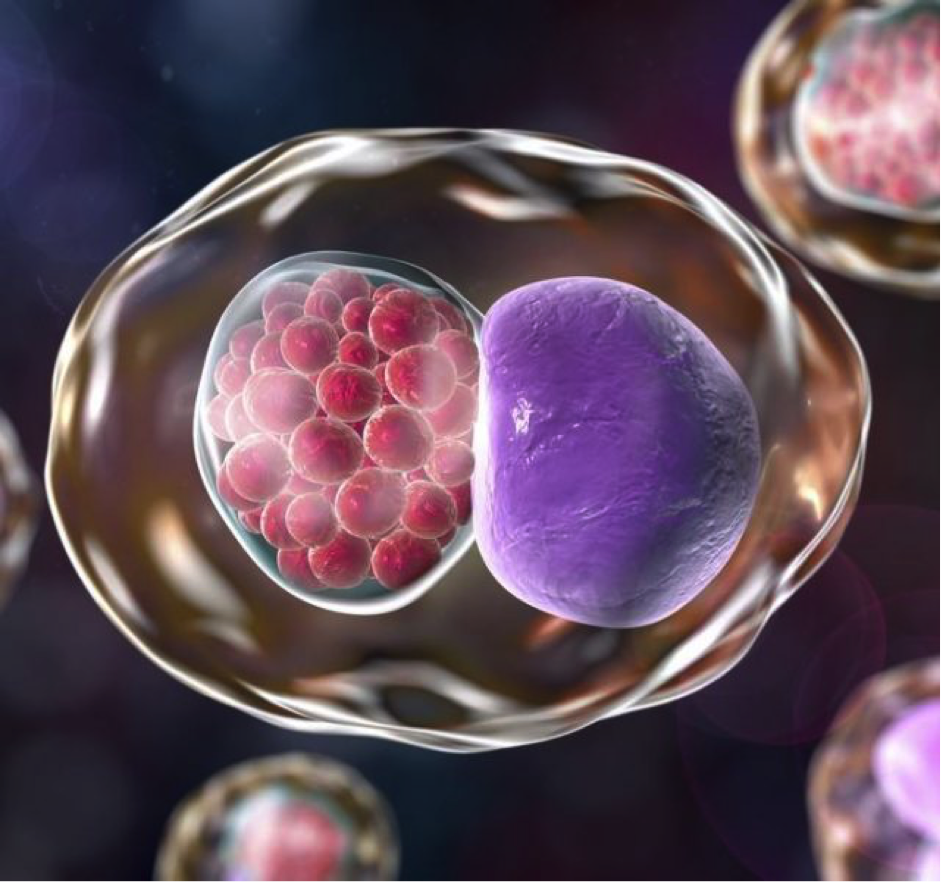
Gonorrhoea
- Caused by the bacterium Neisseria gonorrhoeae, which can grow and multiply rapidly in the warm, moist areas of the reproductive tract
- Most common symptoms include discharge from the vagina or penis and painful or difficult urination.
- Can be treated with antibiotics
- Like chlamydia, if left untreated, gonorrhoea can cause pelvic inflammatory disease, which can lead to chronic pelvic pain and permanent damage to a woman's reproductive organs. This damage may lead to ectopic pregnancy (in which the foetus develops outside of the womb, a condition that can be life-threatening) and infertility.
- In both men and women, gonorrhoea can also infect the mouth, throat, eyes, and rectum and can spread to the blood and joints, where it can become a life-threatening illness.
- Can be transmitted to the foetus during pregnancy.
- Because chlamydia and gonorrhoea often occur together, people who have one infection are typically treated for both by their health care provider.
- To prevent health complications and sexual transmission, treatment should be provided promptly for all persons testing positive for infection, and recent sexual partners should be treated at the same time to prevent reinfection.
- People with gonorrhoea can more easily contract HIV, the virus that causes AIDS. HIV-infected people with gonorrhoea are also more likely to transmit the virus to someone else.
Bacteria that causes gonorrhoeae
Image credit: obtained from the website www.std-gov.org
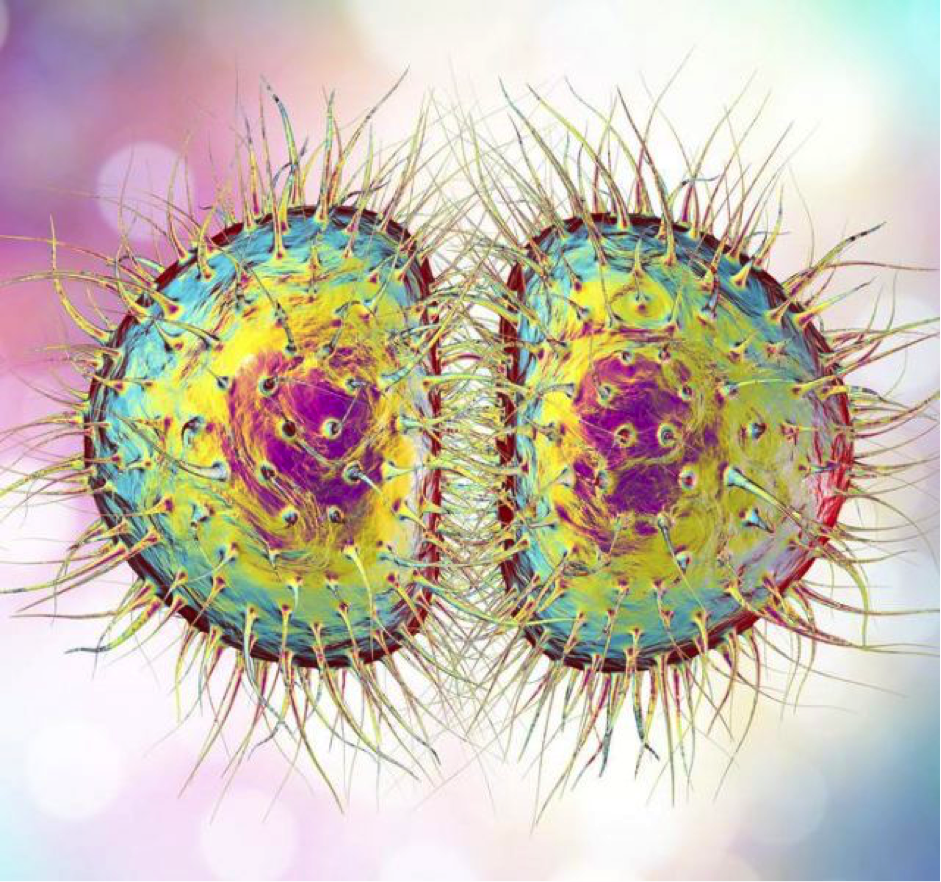
Genital Herpes
- Caused by the herpes simplex virus (HSV)
- There are two different strains, or types: HSV type 1 (HSV-1) and type 2 (HSV-2). Both can cause genital herpes, although most cases of genital herpes are caused by HSV-2.
- Symptoms of HSV-1 usually appear as fever blisters or cold sores on the lips, but it can also infect the genital region through oral-genital or genital-genital contact. Symptoms of HSV-2 are typically painful, watery skin blisters on or around the genitals or anus. However, substantial numbers of people who carry these viruses have no or only minimal signs or symptoms.
- Cannot be cured, but can be controlled with medication
- One medication can be taken daily to make it less likely that the infection will pass on to sex partner(s) or to infants during childbirth.
- Periodically, some people will experience outbreaks of symptoms in which new blisters form on the skin in the genital area; at those times, the virus is more likely to be passed on to other people.
- If a pregnant woman has an outbreak when she goes into labour, she may need to have a caesarean section (C-section) to prevent the infant from getting the virus during birth.
- Pregnant women, especially those who acquire genital herpes for the first time during pregnancy, may pass the infection to their newborns, causing life-threatening neonatal HSV, an infection affecting the infant's skin, brain, and other organs.
The Herpes Simplex virus (HSV)
Image credit: obtained from the website - Microbe online
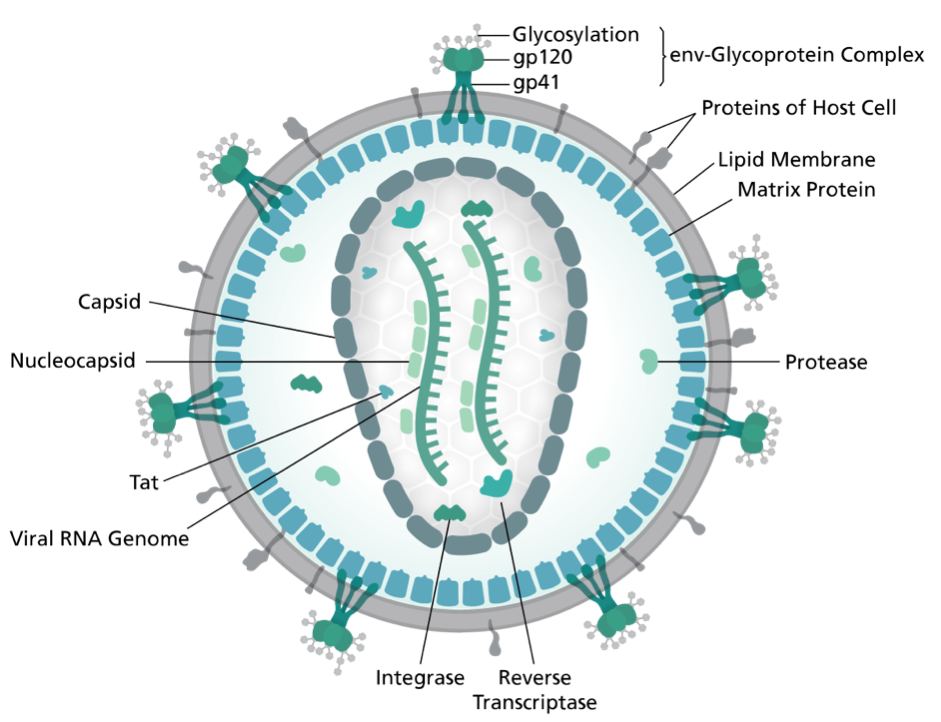
HIV/AIDS
- HIV, human immunodeficiency virus, is the virus that causes AIDS.
- Destroys the body's immune system by killing the blood cells that fight infection. Once HIV destroys a substantial proportion of these cells, the body's ability to fight off and recover from infections is compromised. This advanced stage of HIV infection is known as AIDS.
- People whose HIV infection has progressed to AIDS have a weakened immune system and are very susceptible to opportunistic infections that do not normally make people sick and to certain forms of cancer.
- In people who do not have HIV, the infection can be prevented by many tools, including abstaining from sex, limiting the number of sexual partners, never sharing needles, and using condoms appropriately. Persons who may be at very high risk of HIV infection may be able to obtain HIV Pre-Exposure Prophylaxis or PrEP, which consists of the HIV medication called Truvada, from their doctor to take every day so they can prevent HIV infection. PrEP will not work if it is not taken consistently.
- AIDS can be prevented in those with HIV infection by early initiation of antiretroviral therapy.
- Transmission of the virus primarily occurs during unprotected sexual activity and by sharing needles used to inject intravenous drugs.
- HIV can also spread from mother to foetus during pregnancy and from mother to infant during delivery and breastfeeding. However, treatments are available that can virtually eliminate these types of transmission.
HIV viruses in the bloodstream
Image credit: obtained from the website www.std-gov.org
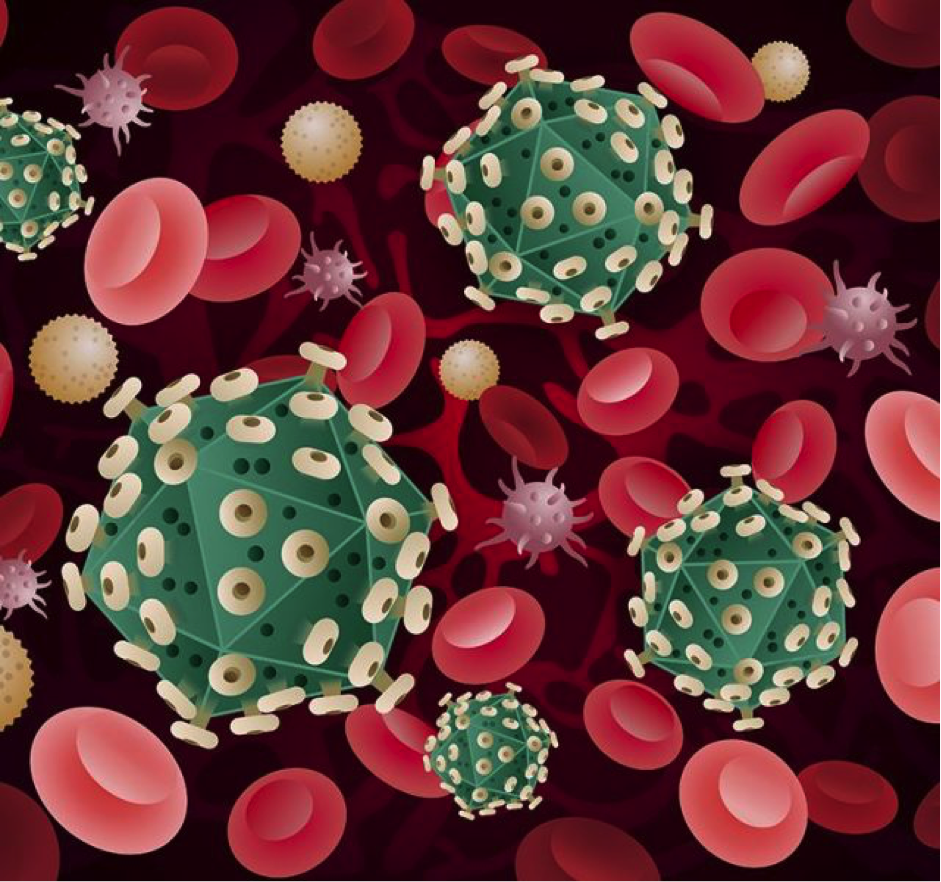
Human Papillomavirus (HPV)
- HPV is the most common STI. More than 40 HPV types exist, and all of them can infect both men and women.
- The types of HPVs vary in their ability to cause genital warts; infect other regions of the body, including the mouth and throat; and cause cancers of the cervix, vulva, penis, anus, and mouth.
- Cannot be cured but can be prevented with vaccines and controlled with medications.
- Genital warts caused by the virus can also be treated.
- Regular screening with a Pap smear test can prevent or detect at an early stage most cases of HPV-caused cervical cancer. (A Pap smear test involves a health care provider taking samples of cells from the cervix during a standard gynaecologic exam; these cells are examined under a microscope for signs of developing cancer).
Human Papillomavirus (HPV)
Image credit: obtained from the website www.std-gov.org
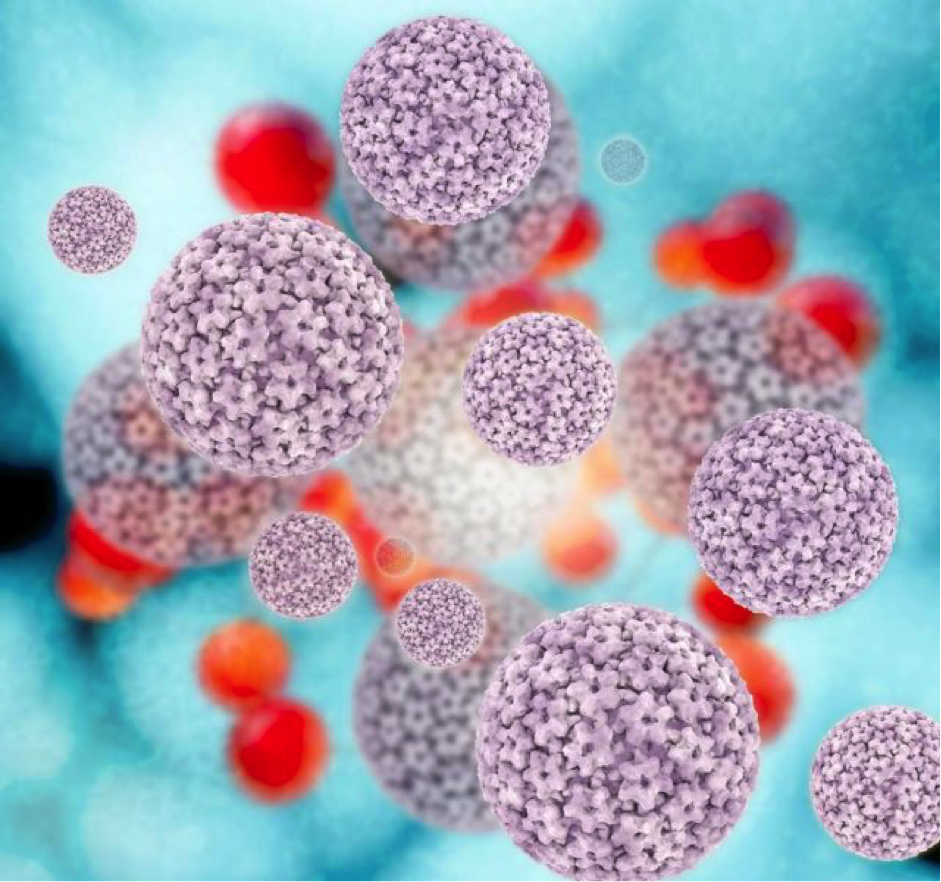
Syphilis
- Caused by the bacterium Treponema pallidum
- Passes from person to person during vaginal, anal, or oral sex through direct contact with syphilis sores
- Syphilis can also be spread from an infected mother to her foetus. In 2001, the number of cases of syphilis was at its lowest in 60 years. But the syphilis rate has increased nearly every year up to 2014, the most recent year for which data are available. Rates have increased among both men and women, but men account for more than 90% of syphilis cases overall.
- The first sign of syphilis is a chancre, a painless genital sore that most often appears on the penis or in and around the vagina. Chancres typically resolve on their own, but the body does not clear the infection on its own.
- Chancres make a person two to five times more likely to contract an HIV infection. If the person is already infected with HIV, chancres also increase the likelihood that the HIV virus will be passed on to a sexual partner.
- Can be treated with antibiotics:
- If recognized during the early stages, usually within the first year of infection, syphilis can be treated with a single injection of antibiotic.
- If not recognized early, or not treated immediately, syphilis may need longer treatment with antibiotics.
- Without treatment:
- Usually spreads to other organs, including the skin, heart, blood vessels, liver, bones, and joints in secondary syphilis.
- Other sores, such as a syphilis rash, can break out in later stages.
- Tertiary syphilis can develop over a period of years and involve the nerves, eyes, and brain and can potentially cause death.
- Can pass to the foetus during pregnancy and to the infant during delivery
- Infants who get syphilis infection in the womb may have misshapen bones, very low red blood cell count (called severe anaemia), enlarged liver and spleen, jaundice (yellowing of the skin or eyes), nerve problems, blindness or deafness, meningitis, and skin rashes.
- Those being treated for syphilis must avoid sexual contact until the syphilis sores are completely healed to avoid infecting other people.
- Persons with syphilis must notify their sex partners so that they also can be tested and receive treatment if necessary.
- Pregnant women with syphilis, especially untreated syphilis, are at an increased risk of miscarriage and stillbirth.
The spiral bacteria that causes syphilis
Image credit: obtained from the website www.std-gov.org
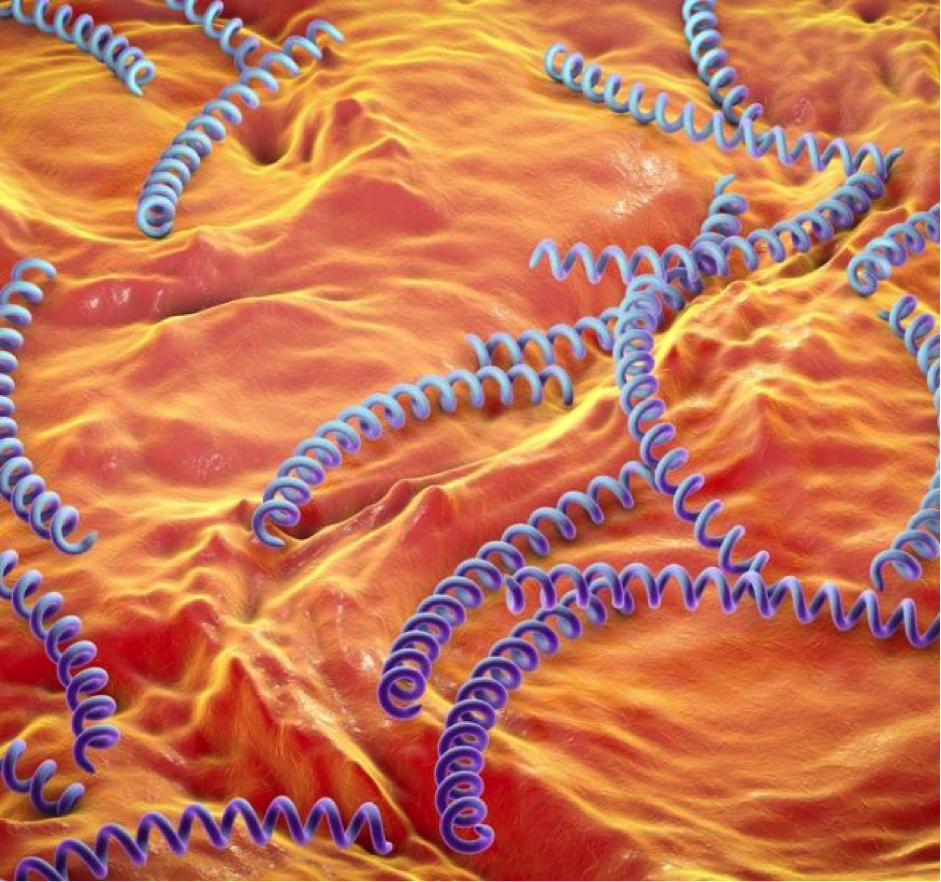
Bacterial Vaginosis
- Occurs when problematic bacteria that are normally present only in small amounts in the body increase in number. Their levels get so high that they replace normal vaginal bacteria and upset the usual balance.
- More likely if a woman douches frequently or has new or multiple sexual partners
- Most common symptom is a thin, milky discharge that is often described as having a "fishy" odour. However, some women will have no symptoms at all.
- Can be treated with antibiotics, typically metronidazole or clindamycin
- Generally, sexual partners of women with bacterial vaginosis do not need to be treated because treatment of partners has not been shown to reduce the risk of recurrence.
- Treatment is recommended for all pregnant women who show symptoms.
- Increases the risk of getting other STIs even if the woman doesn't have any symptoms
- Associated with preterm labour and birth and having a low birth weight baby
- Also associated with pelvic inflammatory disease, an infection of the female reproductive organs, including the uterus and the fallopian tubes (which carry eggs to the uterus), and with infections that commonly occur after surgery
Gardnerella vaginalis, the organism that causes BV (Bacterial Vaginosis)
Image credit: obtained from the website www.std-gov.org
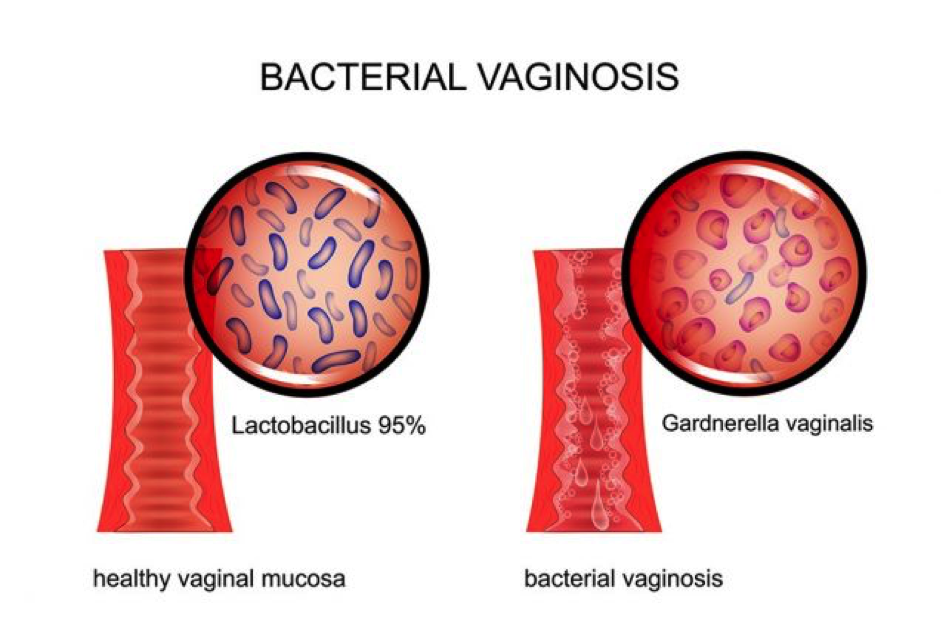
Trichomoniasis
- Caused by the single-celled parasite Trichomonas vaginalis
- Common in young, sexually active women but also infects men, though less frequently
- The parasite can be transmitted between men and women as well as between women whenever physical contact occurs between the genital areas.
- Can cause frequent, painful, or "burning" urination in men and women as well as vaginal discharge, genital soreness, redness, or itching in women. However, it may not cause any symptoms.
- Because the infection can occur without symptoms, a person may be unaware that he or she is infected and continue to re-infect a sexual partner who is having recurrent signs of infection.
- Can be treated with a single dose of an antibiotic, usually either metronidazole or tinidazole, taken by mouth
- Because of re-infection, it is important to make sure that the diagnosed individual and all sexual partners are treated at the same time.
- Retesting is recommended for all sexually active women within 3 months after initial treatment even if they believe their partners were treated.
- Infection during pregnancy is associated with an increased risk of preterm labour or birth and infants with low birth weight.
Trichomoniasis
Image credit: obtained from the website www.std-gov.org

Hepatitis B virus (HBV)
- Causes a serious liver infection that can result in both immediate illness and lifelong infection and disease, leading to permanent liver scarring (cirrhosis), cancer, liver failure, and death.
- Can be treated with antiviral medications.
- Vaccination can prevent HBV infection.
- Spreads through sexual contact, as well as through contact with other bodily fluids, such as blood; through shared contaminated needles used for injecting intravenous drugs; and through tattooing and piercing.
- Pregnant women with HBV can transmit the virus to their infants during delivery, but a series of vaccinations and a shot of hepatitis B immune globulin for the baby beginning at birth can prevent this transmission. Without vaccination, babies born to women with HBV infection can develop chronic infection, which can lead to serious health problems.
- People with chronic HBV infection will need to see a liver specialist with experience treating individuals with chronic liver disease. These individuals need to take special care not to pass on the virus to their sexual partners, and sexual partners should receive hepatitis B vaccine if they are not already immune.
Hepatitis B virus (HSV)
Image credit: obtained from the website www.std-gov.org
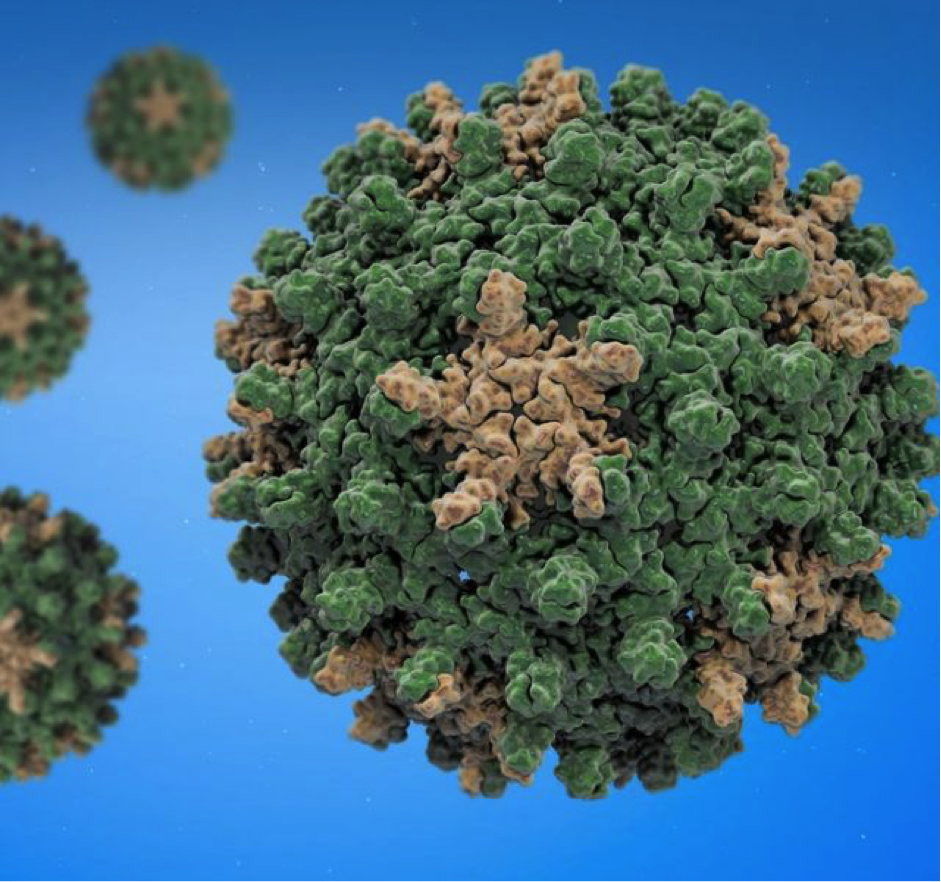
Hepatitis C virus (HCV)
- Serious infection of the liver that can cause an immediate illness but that, in most people, becomes a silent, chronic infection that leads to liver scarring (cirrhosis), cancer, liver failure, and death
- Most infected people may not be aware of their infection because they do not develop symptoms.
- Most commonly transmitted through sharing needles or exposure to infected blood. Less commonly, it can spread through sexual contact or from mother to foetus during pregnancy and delivery.
- Can be treated. New medications seem to be more effective and have fewer side effects than previous options.
Hepatitis C virus (HCV)
Image credit: obtained from the website www.std-gov.org
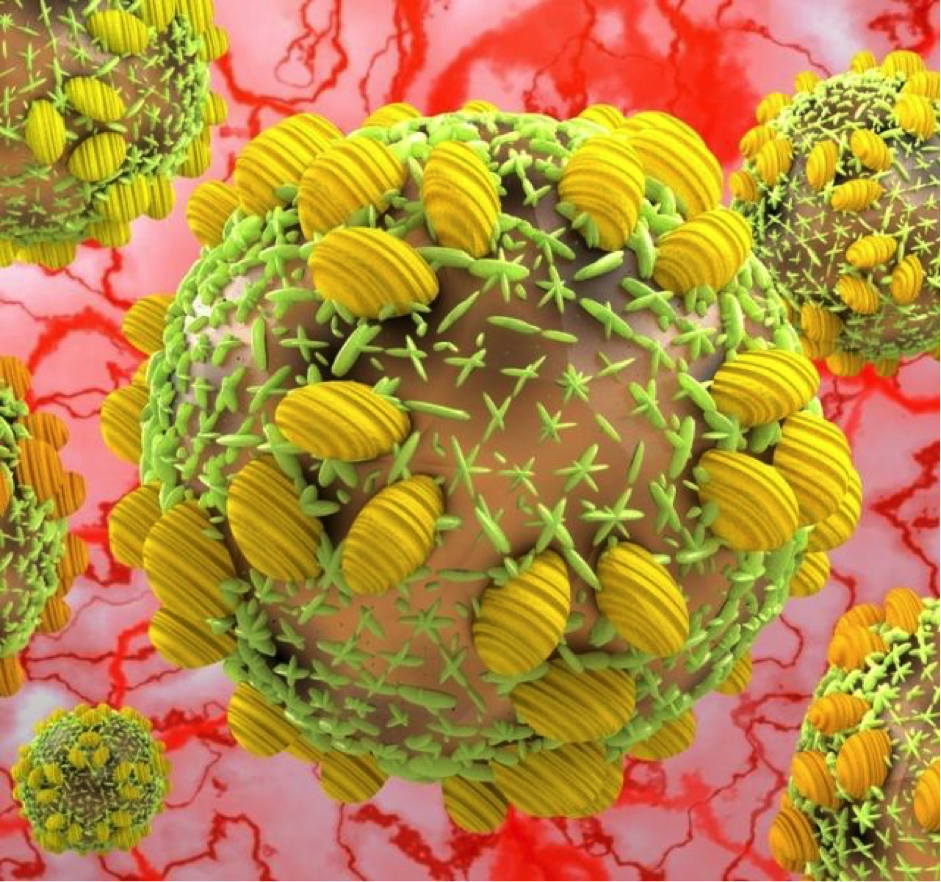
Diagnosis
How do health care providers diagnose a sexually transmitted disease / infection (STD/STI)?
Some STDs/STIs may be diagnosed during a physical exam or through microscopic examination of a sore or fluid swabbed from the vagina, penis, or anus. This fluid can also be cultured over a few days to see whether infectious bacteria or yeast can be detected. The effects of human papilloma virus (HPV), which causes genital warts and cervical cancer, can be detected in a woman when her health care provider performs a pap smear test and takes samples of cells from the cervix to be checked microscopically for abnormal changes. Blood tests are used to detect infections such as hepatitis B, and C or HIV/AIDS.
Because sexually transmitted diseases are passed from person to person and can have serious health consequences, the health department notifies people if they have been exposed to certain STDs/STIs. Not all STDs/STIs are reported, though. If you receive a notice, it is important to see a health care provider, be tested, and start treatment right away.
Screening is especially important for pregnant women, because many STDs/STIs can be passed on to the foetus during pregnancy or delivery. During an early prenatal visit, with the help of her health care provider, an expectant mother should be screened for these infections, including HIV and syphilis. Some of these STDs/STIs can be cured with drug treatment, but not all of them. However, even if the infection is not curable, a pregnant woman can usually take measures to protect her infant from infection.
Is there a cure for sexually transmitted diseases / infections (STDs/STIs)?
Viruses such as HIV, genital herpes, human papillomavirus, hepatitis, and cytomegalovirus cause STDs/STIs that cannot be cured. People with an STI caused by a virus will be infected for life and will always be at risk of infecting their sexual partners. However, treatments for these viruses can significantly reduce the risk of passing on the infection and can reduce or eliminate symptoms. STIs caused by bacteria, yeast, or parasites can be cured using appropriate medication.
Treatment
What are the treatments for sexually transmitted diseases / infections (STDs/STIs)?
STDs/STIs caused by bacteria or parasites can be treated with antibiotics. These antibiotics are most often given by mouth (orally). However, sometimes they are injected or applied directly to the affected area.
The treatments, complications, and outcomes for viral STIs depend on the particular virus (HIV, genital herpes, human papillomavirus, hepatitis, or cytomegalovirus). Treatments can reduce the symptoms and the progression of most of these infections. For example, medications are available to limit the frequency and severity of genital herpes outbreaks while reducing the risk that the virus will be passed on to other people.
Individuals with HIV need to take special antiretroviral drugs that control the amount of virus they carry. These drugs, called highly active antiretroviral therapy, or HAART, can help people live longer, healthier lives and can prevent onward transmission of HIV to others. If a woman with HIV becomes pregnant, these medicines also can reduce the chance that her foetus or infant will get the infection.
Whatever the infection, and regardless of how quickly the symptoms resolve after beginning treatment, the infected person and their partner(s) must take all of the medicine prescribed by the health care provider to ensure that the STI is completely treated. Likewise, they should follow health care provider recommendations about how long to abstain from sex after the treatment is completed to avoid passing the infection back and forth.
Recommended websites
For further reading go to:
- Sexually transmitted infections – a basic guide with photos
- Bacterial vaginosis (BV) - vaginal discharge not considered a sexually transmitted disease
- Sexually transmitted infection – Wiki
_______________________________________________________________________________________________________________________
Are you a healthcare practitioner who enjoys patient education, interaction and communication?
If so, we invite you to criticise, contribute to or help improve our content. We find that many practicing doctors who regularly communicate with patients develop novel and often highly effective ways to convey complex medical information in a simplified, accurate and compassionate manner.
MedSquirrel is a shared knowledge, collective intelligence digital platform developed to share medical expertise between doctors and patients. We support collaboration, as opposed to competition, between all members of the healthcare profession and are striving towards the provision of peer reviewed, accurate and simplified medical information to patients. Please share your unique communication style, experience and insights with a wider audience of patients, as well as your colleagues, by contributing to our digital platform.
Your contribution will be credited to you and your name, practice and field of interest will be made visible to the world. (Contact us via the orange feed-back button on the right).
Disclaimer:
MedSquirrel is a shared knowledge, collective intelligence digital platform developed to share medical knowledge between doctors and patients. If you are a healthcare practitioner, we invite you to criticise, contribute or help improve our content. We support collaboration among all members of the healthcare profession since we strive for the provision of world-class, peer-reviewed, accurate and transparent medical information.
MedSquirrel should not be used for diagnosis, treatment or prescription. Always refer any questions about diagnosis, treatment or prescription to your Doctor.
